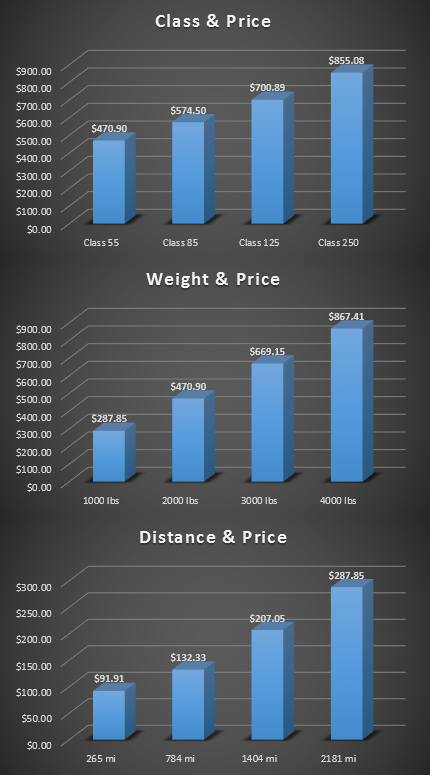REDWOOD LOGIN
Redwood PortalLTL
SCS
SCS Support
Rockfarm
Every year at LTX we meet with hundreds of customers across the country. One of the first questions we are asked as they try to understand the less than truckload (LTL) portion of their supply chain is: “What factors determine my less than truckload cost?”
This is a great question, and unless you understand all of the factors that contribute to your LTL freight spend, you will not realize the cost effective solutions that LTL provides. In this article, we will explain seven factors that influence LTL shipping costs.

The first factor contributing to LTL pricing is the classification of the freight that is being handled.
What is classification?
All LTL freight is classified based on a set of commodity descriptions that are established by the National Motor Freight Classification, or NMFC.
The NMFC has eighteen commodity classes that range from class 50 to class 500. These classes are determined by several factors such as:
The lower the class (e.g. class 50), the easier it is for the carrier to handle the freight without damage. Conversely, higher freight classes represent a commodity that carries a higher chance of damage.
For example, if you ship a pallet of ping-pong balls, they will carry a higher class than a pallet of anvils. Ping-pong balls are lighter and easier to damage, while anvils are heavier and near impossible to damage.
If you remember anything about freight class, remember that class and price are directly correlated. As one goes up, so does the other.
As with all modes of transportation, distance is an important factor that drives LTL cost.
Similar to a shipment’s freight class, distance is also directly correlated to price. The farther a shipment travels from its origin point, the higher the shipment’s cost will be. The fewer the miles between origin and destination, the lower the cost.
You must also note the territory an LTL carrier covers with direct points.
A direct point means the carrier has assets that can cover the entire length of haul from origin to destination. If you go outside of a carrier’s direct points, the carrier will utilize a process called ‘interlining,’ which means that the initial carrier hands off the freight to another LTL carrier who can move the shipment to its final destination.
For example, you have a shipment traveling from Atlanta, Georgia to Portland, Oregon and you choose to utilize a carrier that only has coverage in the Southeast. That carrier will pick up the shipment at its origin location in Atlanta and move it to its furthest direct point where it will transfer the shipment to a carrier that can manage the shipment to the final destination in Portland.
Interlining always carries a higher cost than a shipment that involves only direct points.
Minimum charges are ‘floor level’ prices that the carrier establishes as the absolute lowest charge for a shipment.
LTL carriers set minimums in order to off-set the costs associated with transporting shipments that do not produce the same revenue of heavier shipments.
For instance, if your minimum charge is $75 and you have a shipment that does not meet the carrier’s requirements to receive a discounted rate, then you will be charged a minimum $75 for every shipment meeting that criteria.
All LTL pricing factors in the weight of the shipment.
Within negotiated parameters, weight and cost are inversely related.
The higher the weight, the lower the cost. The lower the weight, the more expensive the cost.

LTL pricing agreements are negotiated with a certain amount of linear floor space a single shipment can consume before reaching a penalty fee. The penalty fee is known as an ‘over-length charge,’ and it can greatly impact cost.
For example, if you know that your average shipment consists of six 48’’ long pallets that can be loaded side by side, then you know your shipment will use twelve feet of linear floor space. You can negotiate this into your pricing agreement so that shipments less than twelve linear feet will receive my full discounted pricing.
Smart shippers understand their freight and know how to avoid receiving over-length charges, as they can be costly.
Accessorial charges are services the carrier provides above normal business-to-business pick-up and delivery.
Common accessorial charges include lift gate charges, residential pick-up or delivery, re-consignment, inside delivery and limited access delivery.
Based on frequency of use, accessorial charges can be negotiated into the pricing agreement through additional flat fees, or in some cases, waived completely.
The most common accessorial charge is fuel surcharge and it is included for every LTL shipment.
Fuel surcharge is an agreed upon percentage of the base cost of a shipment determined by the weekly national average of diesel fuel. For budgeting and auditing purposes, this allows for the cyclical fluctuation of fuel prices.
As a shipper, you should understand clearly your fuel surcharge table to ensure that as fuel rises or falls, you are not paying more than you should for any shipment.
As you can see, there are several factors that control LTL cost and each factor has a different impact. For example, check out the scenarios below demonstrating how price is affected by different variables.

If you lack the specific knowledge of the factors driving your freight, you will certainly experience an impact on your bottom line. LTX is here to help you control your costs and help you understand every aspect of your LTL freight.
We hope you have found this article insightful. If you would like further information, or are in need of a consult, please click the 'Contact Us' button below.
